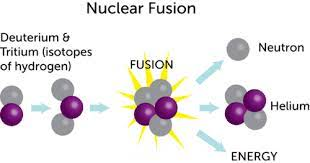Nuclear Fusion Energy | 11 Feb 2022
For Prelims: Tokamak, Nuclear fusion, Difference between Nuclear Fusion & Nuclear Fission.
For Mains: Advantages of Nuclear Fusion, Clean Energy.
Why in News?
Recently, the Scientists in the United Kingdom said they have achieved a new milestone in producing nuclear fusion energy, or imitating the way energy is produced in the Sun.
- Energy by nuclear fusion is one of mankind’s long standing quests as it promises to be low carbon, safer than how nuclear energy is now produced and, with an efficiency that can technically exceed a 100%.
- One kilogram(kg) of fusion fuel contains about 10 million times as much energy as a kg of coal, oil or gas.
What was the Location of Experiment?
- The JET (Joint European Torus facility) site is the largest operational one of its kind in the world.
- The energy was produced in a machine called a tokamak, a doughnut-shaped apparatus.
- A tokamak is a machine that confines a plasma using magnetic fields in a donut shape that scientists call a torus.
- Deuterium and tritium, which are isotopes of hydrogen, were heated to temperatures 10 times hotter than the centre of the sun to create plasma.
- This was held in place using superconductor electromagnets as it spins around, fuses and releases tremendous energy as heat.
- The record and scientific data from these crucial experiments are a major boost for ITER, the larger and more advanced version of the JET.
What is Nuclear Fusion?
- Nuclear fusion is defined as the combining of several small nuclei into one large nucleus with the subsequent release of huge amounts of energy.
- It is the opposite reaction of fission, where heavy isotopes are split apart.
- Harnessing fusion, the process that powers the Sun, could provide a limitless, clean energy source.
- In the sun, the extreme pressure produced by its immense gravity creates the conditions for fusion to happen.
- Fusion reactions take place in a state of matter called plasma. Plasma is a hot, charged gas made of positive ions and free-moving electrons that has unique properties distinct from solids, liquids and gases.
- At high temperatures, electrons are ripped from atom’s nuclei and become a plasma or an ionised state of matter. Plasma is also known as the fourth state of matter.
What are Advantages of Nuclear Fusion?
- Abundant energy: Fusing atoms together in a controlled way releases nearly four million times more energy than a chemical reaction such as the burning of coal, oil or gas and four times as much as nuclear fission reactions (at equal mass).
- Fusion has the potential to provide the kind of baseload energy needed to provide electricity to the cities and the industries.
- Sustainability: Fusion fuels are widely available and nearly inexhaustible. Deuterium can be distilled from all forms of water, while tritium will be produced during the fusion reaction as fusion neutrons interact with lithium.
- No CO₂: Fusion doesn't emit harmful toxins like carbon dioxide or other greenhouse gases into the atmosphere. Its major by-product is helium: an inert, non-toxic gas.
- No long-lived radioactive waste: Nuclear fusion reactors produce no high activity, long-lived nuclear waste.
- Limited risk of proliferation: Fusion doesn't employ fissile materials like uranium and plutonium (Radioactive tritium is neither a fissile nor a fissionable material).
- No risk of meltdown: It is difficult enough to reach and maintain the precise conditions necessary for fusion—if any disturbance occurs, the plasma cools within seconds and the reaction stops.
What are Other International Initiatives on Nuclear Fusion Energy?
- International Thermonuclear Experimental Reactor (ITER) Assembly: It aims to build the world's largest tokamak to prove the feasibility of fusion as a large-scale and carbon-free source of energy. The ITER members include China, the European Union, India, Japan, South Korea, Russia and the United States.
- China’s Artificial Sun: The Experimental Advanced Superconducting Tokamak (EAST) device designed by China replicates the nuclear fusion process carried out by the sun.


.png)